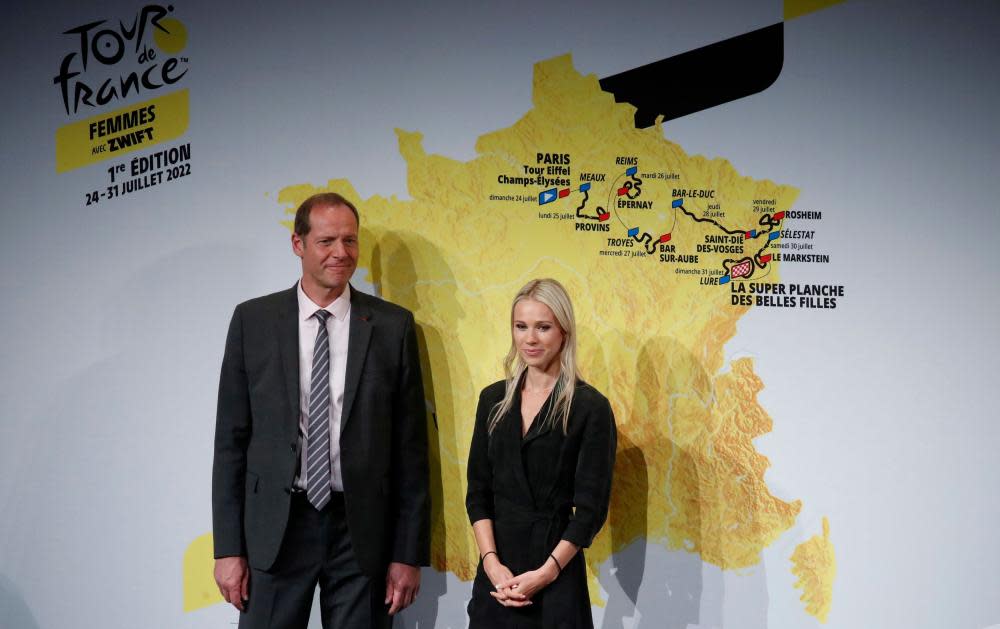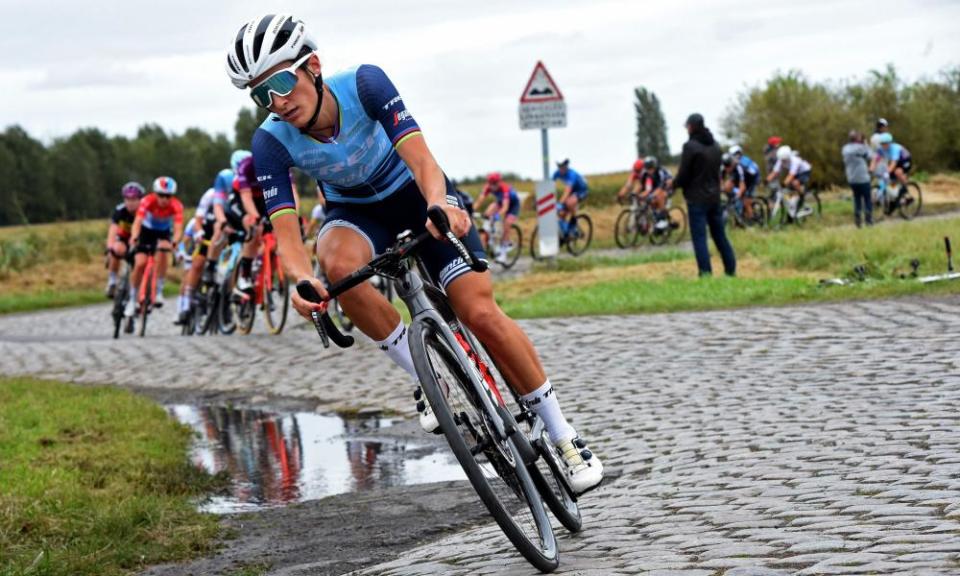Tour de France 2022: women’s race reborn as eight-stage route unveiled

The women’s Tour de France was reborn as the 2022 race route was unveiled in the Palais des Congrès in Paris on Thursday by the newly appointed race director Marion Rousse. The eight-stage race, which begins on 24 July next year, as the men’s Tour de France ends, signifies a long-awaited quantum leap in the profile of women’s racing.
Christian Prudhomme, longstanding director of the men’s Tour, owned by sports promoter ASO, said that the women’s race is built to “endure 100 years” and cited ASO’s support of the growth of women’s cycling, through one day races La Course and Paris-Roubaix, and now of the women’s Tour.
Related: Spectator who caused Tour de France pile-up goes on trial
For the first time, the elite women sat alongside the peloton’s elite men in the cavernous auditorium of the Palais des Congrès as their respective routes were unveiled. Rousse, who described it as a “real honour” to be the director of the women’s Tour de France, added that: “The women’s races we have now are jewels to cherish.”
After launching on the Champs-Élysées, the women’s Tour route zigzags east towards the Vosges mountains and the Haut-Rhin, taking in sprint stages, gravel tracks through vineyards in Champagne, and a final weekend of high-altitude ascents, culminating in the 24% gravel climb to Super Planche des Belles Filles.
“We wanted to start from Paris,” Rousse said of the women’s Tour. “With only eight stages, we couldn’t go down to the Alps or the Pyrenees, the transfers would be too long.” The women’s Tour de France champion will win €50,000 (£42,300) and there is a further pot of €200,000 for stage and classification winners.
The final yellow jersey holder in the men’s Tour, in contrast, wins €500,000 (traditionally shared with teammates) and a further prize pot of more than €2m is on offer for stage victories and classification winners.
Lizzie Deignan, winner of the inaugural women’s Paris-Roubaix this month, described it as “an important day for cycling, not just women’s cycling. It is a key indicator that the sport is still progressing as we are now able to compete in the most well-known bike race in the world. I think the organisers have done a really good job preparing the route for this edition.

“It will showcase the best that women’s cycling has to offer with a stage suited to every type of rider, something I was really hoping for. The route has been designed to offer entertaining racing from start to finish, but also to reach a crescendo with the final stage finishing on the Super Planche des Belles Filles, one of the hardest climbs in professional cycling.”
Rousse added: “The stages obviously are shorter for the women than for the men’s races. The men can go 225km. For the girls, the longest race on our roster is 175km and we even needed special dispensation for that.”
“Each stage is dynamic, different and interesting,” Deignan, who rides for Trek-Segafredo, said. “I’m particularly interested in the fourth stage between Troyes and Bar-sur-Aube; the unpaved roads are unusual and something we don’t often encounter. The inclusion of a stage with gravel sectors will mean it’s likely to be a complete rider who wins the Tour de France Femmes.”
The men’s race begins in Copenhagen on 1 July, with a Grand Départ showcasing the Danish love affair with two wheels, that kicks off with a 13km individual time trial. Two more Danish stages are followed by a 900km transfer to the northern French coast for a series of flat stages, including a finish in Arenberg that takes in 11 sections of the dreaded cobblestones of the “Hell of the North”.

The men’s Tour then heads south towards the Vosges and its own finish at Super Planche des Belles Filles, before skirting the Jura and then tackling the Alps, with summit finishes at the high-altitude Col du Granon and, on Bastille Day, the ascent of the ladder of hairpins leading to Alpe d’Huez.
The denouement is likely to take place in the Pyrenean climbs that have proven a foundation for success for the Tour champion Tadej Pogacar in both 2020 and 2021. Summit finishes at Peyragudes and Hautacam will suit the Slovenian, whose recent win in the Italian Classic, Il Lombardia, further reinforced his dominance of the peloton.
A final time trial on a 40km route between Lacapelle-Marival and Rocamadour, will seal the outcome of the race, prior to the final promenade stage, to the Champs-Élysées, scheduled in the wake of the opening stage of the women’s race.
Pogacar, clearly the rider to beat, whatever the terrain, already has his post-title defence plan sorted. “When I finish my Tour, I’m going in a camper to see the women’s Tour,” the UAE Emirates leader said.

 Yahoo News
Yahoo News 
